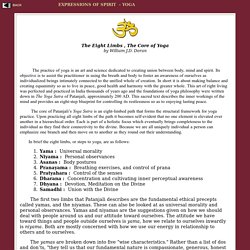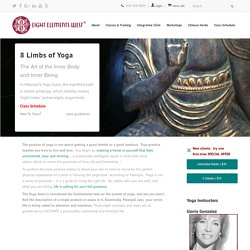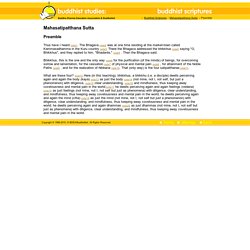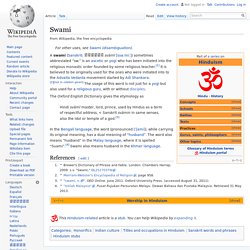

Large hand woven rope hammock. The Eight Limbs of Yoga, A Basic Overview. The Eight Limbs , The Core of Yoga by William J.D.

Doran The practice of yoga is an art and science dedicated to creating union between body, mind and spirit. Its objective is to assist the practitioner in using the breath and body to foster an awareness of ourselves as individualized beings intimately connected to the unified whole of creation. In short it is about making balance and creating equanimity so as to live in peace, good health and harmony with the greater whole. This art of right living was perfected and practiced in India thousands of years ago and the foundations of yoga philosophy were written down in The Yoga Sutra of Patanjali, approximately 200 AD. The core of Patanjali’s Yoga Sutra is an eight-limbed path that forms the structural framework for yoga practice. In brief the eight limbs, or steps to yoga, are as follows: The first two limbs that Patanjali describes are the fundamental ethical precepts called yamas, and the niyamas.
I. 1. II. 1. III. IV. V. VI. VII. The Eight Limbs of Yoga, A Basic Overview. The Art and Philosophy of Ashtanga Yoga. Divine Roots – Back to the Roots. 8 Limbs of Yoga - Eight Elements West. 2 Niyama – Observances – reverence for your home Yama sets the stage for Niyama, for doing right.

Cleansing sets the stage for right activities and energies to take root. Niyama is concerned with discipline and spiritual observances – how we treat ourselves, or begin to cultivate the inner being. These are sometimes called observances, the do’s, or the thou -shalts. There are five niyamas: Purity: Sauca All of the 8 elements ! Contentment: Santosa • Appreciate what you have. • Appreciate who you are. • Appreciate the small things every day. • Seek happiness in the moment, take responsibility for where you are, and choose to grow from there. • Live graciously. Austerity: Tapas heat Show Disciplined use of energy, in body, speech, and mind.
Attention to body posture, attention to eating habits, attention to breathing patterns – these are all tapas. Cheat sheets for the Ashtanga yoga series (PDF) - AshtangaYoga.info. Mahasatipatthana Sutta - Preamble. Mahasatipatthana Sutta Preamble Thus have I heard note1.

The Bhagava note2 was at one time residing at the market-town called Kammasadhamma in the Kuru country note3. There the Bhagava addressed the bhikkhus note4 saying "O, Bhikkhus", and they replied to him, "Bhadante," note5 . Then the Bhagava said: Swami. A swami (Sanskrit: स्वामी svāmī [sʋaːmiː]) sometimes abbreviated “sw.” is an ascetic or yogi who has been initiated into the religious monastic order founded by some religious teacher.[1] It is believed to be originally used for the ones who were initiated into to the Advaita Vedanta movement started by Adi Shankara.[2][not in citation given] The usage of this word is not just for a yogi but also used for a religious guru, with or without disciples.

The Oxford English Dictionary gives the etymology as Hindi svāmī master, lord, prince, used by Hindus as a term of respectful address, < Sanskrit svāmin in same senses, also the idol or temple of a god.[3] In the Bengali language, the word (pronounced [ˈʃami]), while carrying its original meaning, has a dual meaning of “husband”. The word also means “husband” in the Malay language, where it is spelled “Suami”.[4] Swami also means husband in the Khmer language.
Training Schedule - Mendoza Martial Arts & Training. A Beginner's Guide to Knife Fighting. 4-Minute Neck and Shoulders Stretch at Your Desk. YMAA Homepage - A meeting place for all interested in Martial Arts, Qigong, Health and Wellness. Tai chi for beginners - Yang style Form Lesson 1. Tai Chi Fighting! Taijiquan Martial Applications (Yang-style 37-postures) YMAA. Shaolin warrior training. T'ai chi ch'uan. Medical research has found evidence that t'ai chi is helpful for improving balance and for general psychological health, and that it is associated with general health benefits in older people.[2] Overview[edit] .

T'ai chi ch'uan theory and practice evolved in agreement with many Chinese philosophical principles, including those of Taoism and Confucianism. T'ai chi ch'uan training involves five elements, taolu (solo hand and weapons routines/forms), neigong & qigong (breathing, movement and awareness exercises and meditation), tuishou (response drills) and sanshou (self defence techniques). While t'ai chi ch'uan is typified by some for its slow movements, many t'ai chi styles (including the three most popular – Yang, Wu, and Chen) – have secondary forms with faster pace. It is purported that focusing the mind solely on the movements of the form helps to bring about a state of mental calm and clarity.
Some other forms of martial arts require students to wear a uniform during practice. Note: Underground Bare Knuckle Boxing in the UK. Shoulder & Neck Acupressure Points for Relieving Stress.